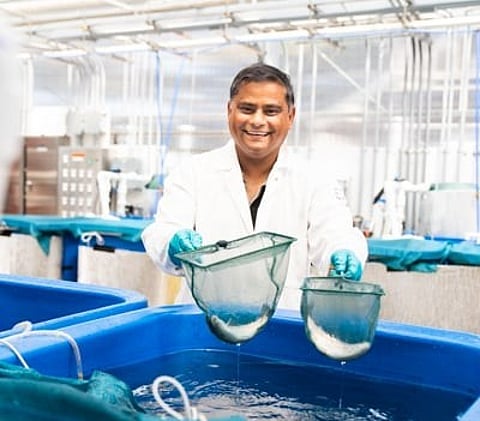

Pallab Sarker on July 12, 2021, at CASFS
Nick Gonzales/UC Santa Cruz
The ecological aquaculture lab team at UC Santa Cruz, California, has launched a new study that includes new aquaculture feed formulations based on microalgae for farmed rainbow trout that can replace traditional fishmeal ingredients.
After testing different levels of a marine microalgal species called Nannochloropsis sp. QH25 in the diets, the researchers found that the same levels of fish growth, nutritional value for humans, potential cost-effectiveness, and other key metrics obtained with fishmeal were maintained.
"Aquaculture can help to feed our growing population, but right now, it too often comes at a surprising cost to wild fish. So we and others across the industry have been working relentlessly to find solutions that don't put further stress on ocean ecosystems," explained lead author Pallab Sarker.
The next step will be to develop a formula that also replaces fish oil and evaluate the possibility of increasing the amount of microalgae to avoid the use of ingredients typically sourced from land-based agriculture.
The first microalgae formulations made by the researchers did not convince the trout, and they did not grow as well as expected. According to the study, this was because the taste of the microalgae was not as attractive as that of fish, and therefore, they ended up eating less, which affected their development.
"After the disheartening results from our prior study, we learned that we could try adding taurine and lecithin as feeding stimulants, and that ended up being a breakthrough for the current study," assured Sarker.
With the addition of taurine and lecithin to enhance the taste and smell, the adaptation of new processing techniques, and replacing the 'cold pellet' process with an extrusion process involving high temperature and pressure, the research team members began to see positive results.
One of the drawbacks of promoting the microalgae production industry at present is that it is still very expensive. Nannochloropsis sp. can be used as long as the leftovers from human supplement production are recycled.
"Microalgae is still a pricey ingredient, due to production and processing costs, but we hope that this type of research, showing the promises of microalgae, can lend further motivation to help the industry solve that problem of cost," Sarker concluded.
In 2024, Norwegian Institute of Food, Fisheries and Aquaculture Research (Nofima) researchers concluded that microalgae can also be considered a sustainable ingredient for salmon feed after several trials in which salmon accepted all the experimental feeds.
